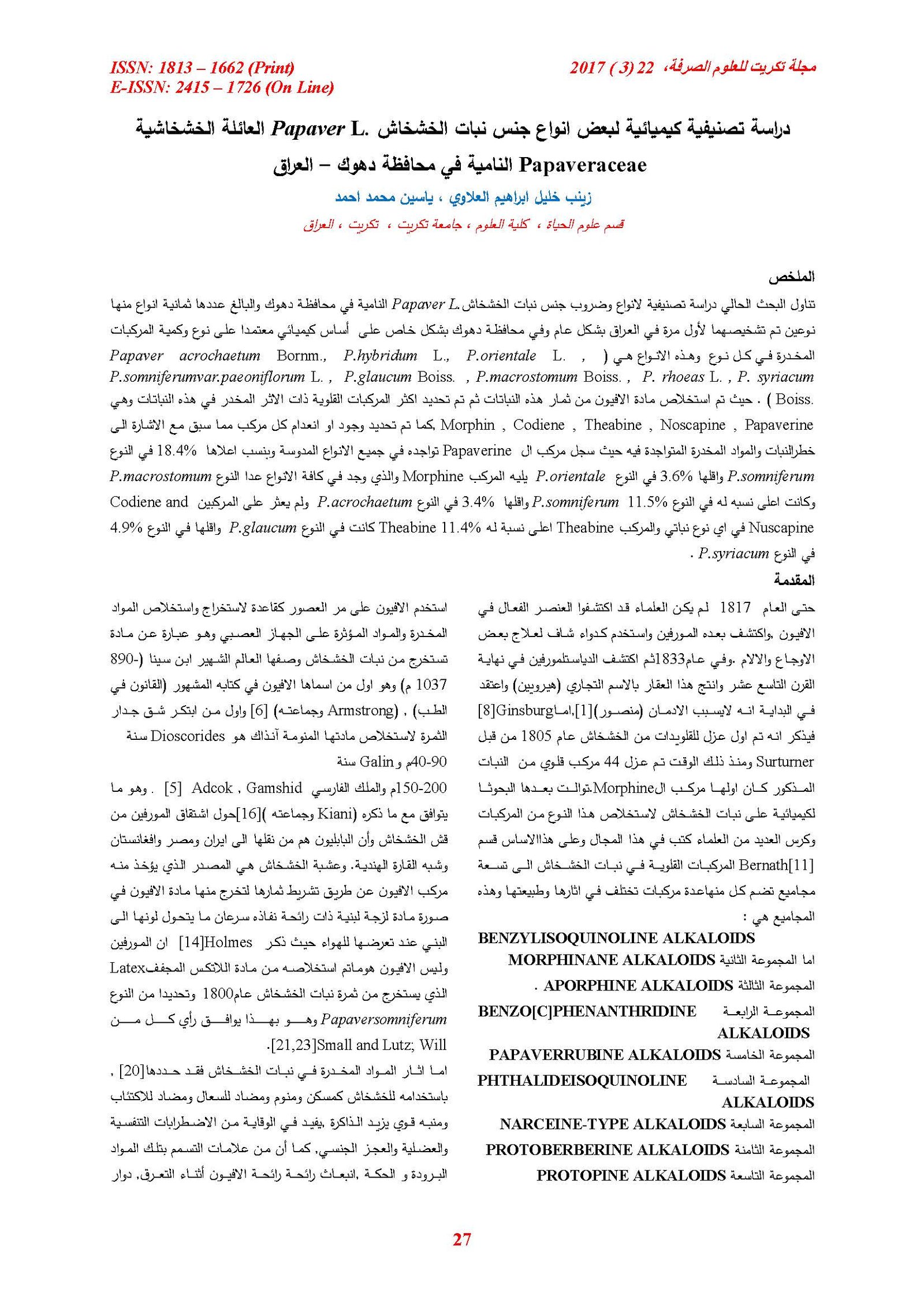Taxonomical and Chemical for Certain spesies of the genus Papaver L. from Papaveraceae grown in Province Dohuk – Iraq
Main Article Content
Abstract
The current research include taxonomic study of the types and forms of Genus poppy Papaver L.which growth in the government of Dohuk . eight species of which two have been diagnosed with the for the first time in Iraq in general and in the Government of Dohuk in particular on the chemical basis of the travel depending on the type and quantity of narcotic vehicles in all type and these types is (Papaveracrochaetum Bornm. , P.hybridum L., P.orientale L., P.somniferum var.paeoniflorum L., P.glaucum Boiss., P.macrostomum Boiss., P. rhoeas L., P. syriacum Boiss. ) .Where opium was extracted from the fruits of these plants have been identified, and more alkaline compounds that impact the drug in these plants which Morphin, Codiene, Theabine, Noscapine, Papaverine, were also identified the presence or absence of each compound Previously with reference to the plant and substance abuse located where the risk of where the material recorded papaverine in all species found the upper percentage in P.somniferum 18.4% and the lower percentage in P.orientale 3.6% ,and the compound Morphine was found in all species except the species P.macrostomum the upper percentage was 11.5 % in P.somniferum and the little in P.acrochaetum while the Codiene and Noscapine were not found in any species and the Thebiene was found in all species the high quantity was 11.4 % P.glaucum and low in P.syriacum 4.9%
Article Details

This work is licensed under a Creative Commons Attribution 4.0 International License.
Tikrit Journal of Pure Science is licensed under the Creative Commons Attribution 4.0 International License, which allows users to copy, create extracts, abstracts, and new works from the article, alter and revise the article, and make commercial use of the article (including reuse and/or resale of the article by commercial entities), provided the user gives appropriate credit (with a link to the formal publication through the relevant DOI), provides a link to the license, indicates if changes were made, and the licensor is not represented as endorsing the use made of the work. The authors hold the copyright for their published work on the Tikrit J. Pure Sci. website, while Tikrit J. Pure Sci. is responsible for appreciate citation of their work, which is released under CC-BY-4.0, enabling the unrestricted use, distribution, and reproduction of an article in any medium, provided that the original work is properly cited.
References
5- Adcock, J.J. (1991). Peripheral opioid receptors and the cough reflex. Respir Med :85(Suppl A):6-43.
6- Armstrong, S.C., G.H. Wynn, and N.B.Sandson, (2009). Pharmacokinetic Drug Interactions of Synthetic Opiate Analgesics. Psychosomatics: 50(2): 169-76.
7- Bernath, J .and Nemeth, E.(2003). Stability and Variability of Alkaloid Accumulation in Poppy (Papaversomniferum L.) Induced by Crossing.Vol. 1: 675 pp
8- Bernath, J. (2005). Poppy The Genus Papaver: Medicinal and Aromatic Plants Industrial Profiles. Hardwood. Academic Publishers. Amstrdam. Netherlands. 36-38
9- Brodbar, A. S. Mesry, and A. Yousofic, A.(1975). Acute opium poisoning: a report of two hundred cases in Iran. Anaesthesia.Vol.30.NO.2:7-223
10- Garnock - Jones, P.J. (2012). Checklist of Dicotyledons Naturalised in New Zealand. 4. Rhoeadales. New Zealand Journal of Botany, Vol. 17: 303 -310.
11- Ginsburg, D. (1962). The Opium Alkaloids. Interscience, New York.US
A. 111.
12- Gravenstein, J.S. R.A. Devloo, and H.K. Beecher, (1954). Effect of antitussive agents on experimental and pathological cough in man. J Appl Physiol. 7(2):119-39.
13- Heydary, M., M.H. Hashempur, A. Zargaran, (2013). Medicinal Aspects of Opium as described in Avicennas Canon of Medicine, Acta med-histAdriat : 11(1) :101-111.
14- Holmes, H.L. (1952). The Alkaloids, Chemistry and Physiology, Academic Press Inc. Publishers. New York : p. 2.
15- Kattimani, R.R.S., and H.K. Sharma, (2010). Opium Abuse and Its Management: GlobalScenario. National Drug Dependence TS.
16- Kiani, H.M. Nimrouzi, and M. Parsaei, (1975 ). Introduction of an Outstanding Scientist of Iranian and Islamic Traditional Medicine: Emadodin. Mahmoud –IbnMasoud Shirazi. Journal of Islamic and Iranian Traditional Medicine.2(3): 4-5.
17- Kryzmanski, J. and R. Jonsson, (1999). Poppy. Oil Crops of the World. Their Breeding and Utilization. McGraw Hill, New York..
18- Mimgli, Z. and Grey- Wilson, C. (2008). Flora of China. 7: 278–280.
19- Post, G. E. (1933). Flora of Syria, Palestine and Sinai, Vol. II , American Press, Beirut , 34 pp.
20- Sleigh, J. (2010). Disentangling Hypnos from his poppies. Anesthesiology.113(2): 2-271.
21-Small, L.F, and R.E. Lutz, (1932). Chemistry of the Opium Alkaloids, Public Health Reports. U.S Govt Printing Office, Washington, 103(2): p. 138.
22- Townsend, C. C., and E. Guest (1980). Flora of Iraq. Vol. 4. Ministry of Agriculture Agrarian Reform. Republic of Iraq.784-809.
23- Weill, P. B. (1950) "The Structure of Morphine", United Nations Bulletin on Narcotics, Vol.1.No.2, p.8.
